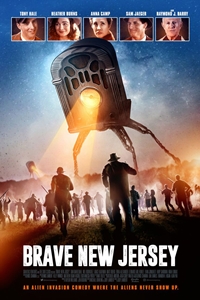"Leading the young ladies of "Step" into the future"
Coming to theaters today is a new documentary about an all-girls’ step-dance team from Baltimore, Maryland called "Step". The team, a mix of confident and determined young personalities, is trying to win their first championship. Throughout their year long journey the girls face trying obstacles in the form of the everyday drama of being a teenager in high school but also the barriers of being from low income families who are doing their best to make a future for their children. Add in the turmoil of being in a city experiencing protesting and riots between citizens and authority figures.
What's makes "Step" so unique, apart from the likable young women and the joyous aspect of watching a team come together despite the hardships, is the fact that the film provides a viewpoint for the people that are trying to maintain the path for these young women to travel. The parents, the teachers, and the counselors at the school are provided a genuine portrayal, one that shows the worry associated with preparing young women for roles in the real, tumultuous world.
The Phoenix Film Festival had a quick opportunity to sit down with the young women and administrative team behind the Baltimore Leadership School for Young Women (BLSYW).
This behind-the-scenes look at the operation of a school can create some disruption in the day-to-day aspects of running an education facility. When talking with Paula Dofat, the Director of College Counseling at BLSYW, we asked if she had any apprehensions before the start of the filmmaking process, specifically with letting a film crew come into the school and have such an intimate, realistic, and genuine portrayal of school life? Ms. Dofat explains:
We wanted to make sure that the integrity of our jobs, and how we do our jobs, was maintained…and that was shown. I'm doing what I have to do. So it's not a secret, if they pull out any of the deleted scenes, I threaten the kids. And I tell them things like, "I wish you would come back to my office without that, and let's see what's going to happen.” And I say things like, "I feel froggy." And they're like, "That means you're going to jump?" "Yeah, so where's my stuff?" I'm more of the the realist. I'm the one who will hold their feet to the fire.
Part of Ms. Dofat's job is to prepare these young women for the future. To make sure they are ready to go to college and the get the education they need to make life better in the future. It's molding and shaping these young women, sometimes through tough love, but also with an approach that generates accountability and responsibility. When talking about how she approaches this aspect Ms. Dofat explains:
I'm the one who's there to tell them, "Check this out. At some point nobody's going to give a doggone about you. So you'd better care. So have your stuff together, know what you're doing, know how you're getting there." Right. Because this thing that we have going on here, this is a great foundation, and you need to take it with you. But at the same time, know that every place you go is not going to be like that. So let's get it together. Making sure that they're in a position. That they're not going to need people in certain ways. That's why I make sure that when they are off to college, they have the least amount of debt. I will overlook a name brand school any day, any time of the week, for a smaller school that's willing to make sure my kid is going to come out and not owe money. So I really don't care about the name of your school. I care about - is it a good fit academically for my kid, whoever that kid is for me. And whether it's going to be a good financial fit. If you can't do that for me, keep it moving. Appreciate you, I will say nice things about your school, but none of my kids will go there. And I have no qualms about that. I'm also a huge historically black college supporter. There's 103 of them. A good majority of our girls go to historically black colleges. There's something that happens there. And I support all schools, but there's something that happens there that's very, very magical. And it cannot be duplicated. And I'd love to dispel the myth, the lie, that those schools do not have money, that they do not present great opportunities, and you cannot be employed. So I make sure that they have opportunity at all schools.
In one of the most compelling scenes late in the film, Ms. Dofat's emotion overwhelms her. It happens when she is trying to get Blessin Giraldo, the team captain and fierce personality of the team, into a college. It's a passionate scene of an educator pleading for one of their students. Ms. Dofat explains why this scene played out the way it did.
Can we give you some context very quickly. We were 30 days before graduation. We had 30 days left. And there was no way on God's green earth that that young lady (pointing at Ms. Giraldo) was going to walk out of that school and not have the same opportunity that everybody else in that school had, or everybody else in the United States. So if I had to cry, if I had to go and cajole…that girl was going someplace.
Director Amanda Lipitz makes this documentary with an emphasis on change, specifically concerning the perception of the city of Baltimore. But the filmmaking process created more than Ms. Lipitz could have ever expected. She explains:
I wanted to make a musical. I wanted to make a musical documentary that changed the story about Baltimore. That was the impetus of it, changing the conversation about Baltimore. I was completely and utterly inspired by these young women. The young women seated at this table, and the 19 of them who are not here with us. Every single one of them had a story. And truly, I made it for them. I didn't make it thinking that it was going to go to Sundance or be bought by Fox or be sitting here with all of you. I just made it so that they would've been proud to have been a part of it. And that's all that ever mattered to me. So for me, I have just incredible amounts of respect and love. We're a family for these women. And their mothers and their extended families for being brave - to share their stories, for trusting me to tell it. And for continuing to inspire people all over the world by continuing to work, so that this film gets the opportunity we just never ever, ever, ever dreamed it would have.
When the group of young women, the filmmaker, and the administration from the school talked about what they hoped audiences would take away from this film, Coach Gari McIntyre (the kids call her Coach G) provided a poignant and fitting takeaway. Coach McIntyre explains:
What I hope people take away, especially mentors and educators, is that they look at this and see themselves, like as a tribute to what they do. And hopefully it keeps them going every day. 'Cause you get discouraged. I'm sure all of us up here have gotten discouraged. All of us in this room have gotten discouraged in what we do. And it's hard to find that passion and that fire that you had when you first wanted to go into it. And then if you don't mentor or do anything, I hope that people really do find time in their day to pay forward whatever they're doing, whatever they're good at. Art, music, journalism, dance - doesn't have to necessarily be sports. Engineering, math, technology, all of those things.
The students of the Baltimore Leadership School for Young Women are in good hands. "Step" can be seen at Harkins Camelview at Fashion Square today.



































